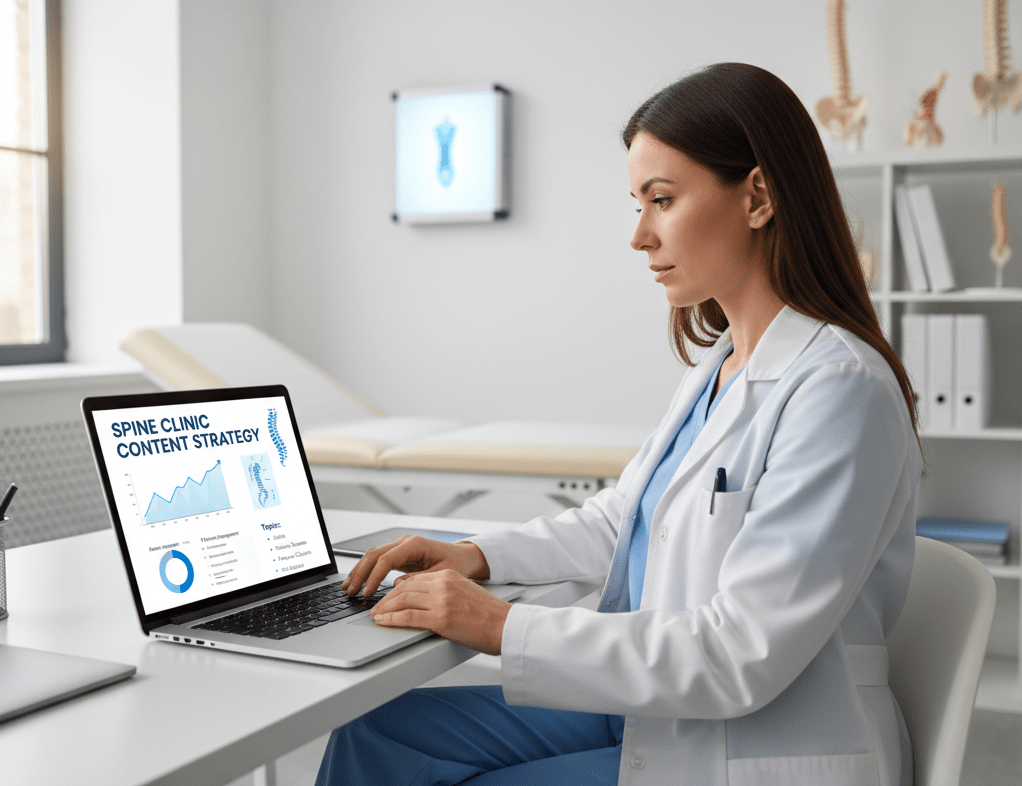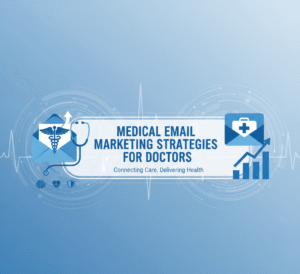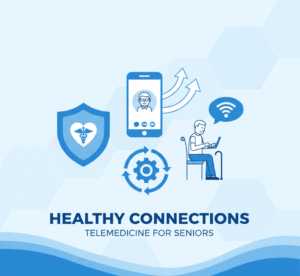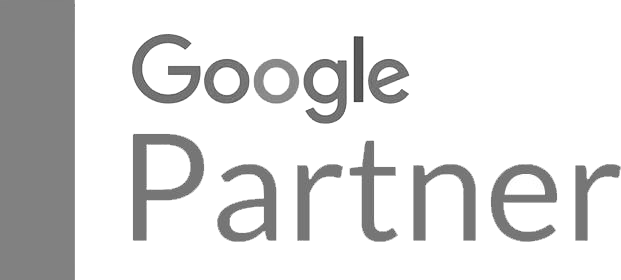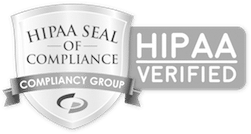“Build a digital Resource Hub filled with patient-focused answers, expert guides, and trust-building assets to perfect your Spine Clinic Content Strategy.”
Millions of people wake up with back pain every single day. What’s the first thing many of them do? They grab their phone or sit down at their computer and type their symptoms into Google. They’re searching for answers, for understanding, and most importantly, for relief. They’re looking for a trusted authority to guide them. The question is, will they find you?
If your spine clinic’s website is little more than a digital brochure—listing your services, your location, and your phone number—you are missing a massive opportunity. Today’s patients are researchers. They sift through information, compare options, and build trust long before they ever pick up the phone to book an appointment. Simply stating that you offer chiropractic care or spinal decompression is no longer enough. You must show them why you are the expert.
This is where a powerful spine clinic content strategy comes into play. It’s not about flashy ads or pushy sales tactics. It’s about building a comprehensive “Resource Hub” on your website that answers your potential patients’ most pressing questions. It’s about educating, empowering, and establishing your clinic as the go-to authority on spinal health in your community. This guide will walk you through exactly how to build this content engine, turning your website into a magnet for well-informed, qualified patients who are actively seeking the solutions you provide.
Section 1: Why Your Clinic Needs More Than Just a Website—It Needs a Resource Hub
Let’s be clear: content marketing is not a “nice-to-have” for a modern healthcare practice. It’s a fundamental part of a successful growth strategy. For spine clinics, chiropractors, and pain management specialists, it is arguably the most effective tool for long-term patient acquisition and retention. Here’s why.
Building Trust in a Crowded Market
When someone is in pain, they are vulnerable. They are seeking a healthcare provider they can trust completely. A generic website doesn’t build that trust. However, a website filled with helpful, informative content does.
Imagine a potential patient suffering from sciatica. They visit two different clinic websites.
- Clinic A’s Website has a single page that says, “We treat sciatica.”
- Clinic B’s Website has an in-depth article explaining what sciatica is, a video demonstrating three safe stretches for sciatic nerve pain, a downloadable guide on ergonomic setups to prevent flare-ups, and a patient testimonial video from someone who found relief at their clinic.
Which clinic do you think the patient will call? The answer is obvious. Clinic B has already provided value. They have demonstrated their expertise, shown empathy for the patient’s condition, and started building a relationship of trust. This is the core of patient education for spinal health—it’s marketing that doesn’t feel like marketing.
Dominating Search Engines with Back Pain SEO
How do patients find you in the first place? Through search engines like Google. Google’s primary goal is to provide its users with the most relevant, high-quality answers to their questions. A robust content strategy directly fuels your Search Engine Optimization (SEO) efforts.
Every time you publish a high-quality blog post about “common causes of lower back pain” or a detailed guide on “non-surgical treatments for a herniated disc,” you are doing two things:
- Answering Patient Questions: You are providing the exact information people are searching for.
- Creating SEO Assets: You are creating new pages for Google to index, each one targeting specific keywords related to back pain.
A website with five pages has five chances to rank. A website with a 50-article Resource Hub has 50 chances to rank. This is how you start to appear for a wide range of searches, from broad queries like “chiropractor near me” to precise, high-intent searches like “spinal decompression for bulging disc in [Your City].” This is the essence of effective healthcare content marketing.
Attracting Qualified, Well-Informed Patients
The goal isn’t just to attract chiropractic patients; it’s to attract the right patients. These are individuals who are educated about their condition and understand the value of the treatments you offer. Content marketing pre-qualifies your patients.
When a patient reads your detailed guide on the benefits of physical therapy post-treatment, they arrive at their first appointment with realistic expectations and a better understanding of their care plan. They are more likely to be compliant with treatment and invested in their own recovery. This leads to better patient outcomes and more positive reviews, creating a virtuous cycle of growth for your practice. It is the most effective form of non-surgical back pain marketing because it focuses on empowerment, not just a sales pitch.
Section 2: Architecting Your Content: The Three Stages of the Patient Journey
A successful spine clinic content strategy doesn’t just involve creating random articles. It requires a structured approach that meets patients where they are in their decision-making process. We can break this down into three key stages: Awareness, Consideration, and Decision. Your Resource Hub should have content tailored for each stage.
Stage 1: The Awareness Stage (Answering “What’s Wrong?”)
At this stage, individuals are experiencing symptoms—a dull ache, a sharp pain, stiffness—and are trying to understand what’s happening. They are asking “why” and “what” questions. Your goal here is to provide clear, accessible answers and establish your initial authority.
- Content Focus: Educational, problem-focused, and symptom-oriented.
- Keywords to Target: These are often question-based or symptom-focused.
- “Causes of lower back pain when standing”
- “Symptoms of a pinched nerve in the neck”
- “Sharp pain between the shoulder blades”
- “Is my mattress causing my back pain?”
- “Difference between muscle strain and disc injury”
- Content Formats:
- Blog Posts: This is the bread and butter of the Awareness stage. Create posts that directly answer these common questions. (See our list of blog topics for spine specialists below.)
- Infographics: A visual diagram showing “5 Common Posture Mistakes” is easy to understand and highly shareable.
- Short Videos: A 2-minute video where a doctor explains the three most common reasons for morning back stiffness can be incredibly effective.
Example Awareness Stage Topics:
- “Understanding Sciatica: Is It More Than Just Leg Pain?”
- “The Top 5 Lifestyle Habits That Are Hurting Your Spine”
- “Could Your Desk Job Be the Source of Your Upper Back Pain?”
- “Spinal Stenosis vs. a Herniated Disc: How to Tell the Difference”
- “A Beginner’s Guide to Spinal Anatomy”
Stage 2: The Consideration Stage (Exploring “How Can I Fix It?”)
Once a person has a better understanding of their problem, they move to the consideration stage. They are now actively researching solutions and treatment options. They are comparing different approaches and trying to figure out the best path forward. Your content should guide them through these options, positioning your non-surgical, patient-centered approach as the ideal choice.
- Content Focus: Solution-oriented, comparative, and treatment-focused.
- Keywords to Target: These keywords often include treatment types or comparisons.
- “Non-surgical treatment for herniated disc”
- “Benefits of spinal decompression therapy”
- “Chiropractic adjustments for neck pain”
- “Physical therapy exercises for lower back pain”
- “Acupuncture vs. chiropractic for sciatica”
- Content Formats:
- In-Depth Guides: Create comprehensive pillar pages that cover a specific condition and its treatments in great detail.
- Comparison Articles: Write balanced articles that compare different treatment modalities (e.g., “Choosing the Right Treatment: Chiropractic Care vs. Physical Therapy”).
- Treatment Explainer Videos: A detailed video showing how a spinal decompression machine works can demystify the process and reduce patient anxiety.
- Downloadable Checklists: “10 Questions to Ask Your Spine Specialist Before Starting Treatment.”
Example Consideration Stage Topics:
- “The Ultimate Guide to Non-Surgical Spinal Decompression”
- “How Chiropractic Adjustments Work to Restore Spinal Health”
- “A Patient’s Guide to Physical Therapy for Back Pain Recovery”
- “Exploring Your Options: When to Consider Injections vs. Conservative Care”
- “What to Expect During Your First Chiropractic Visit”
Stage 3: The Decision Stage (Deciding “Who Can Help Me?”)
At this final stage, the patient is ready to choose a provider. They are looking for signals of trust, expertise, and proof that you can deliver results. Your content now needs to focus on your specific clinic, your team, and your unique approach to care.
- Content Focus: Provider-focused, trust-building, and results-oriented.
- Keywords to Target: These keywords are often branded or include “best,” “top,” or location modifiers.
- “[Your Clinic Name] reviews”
- “Best chiropractor in [Your City]”
- “Top-rated spine clinic near me”
- “[Your Doctor’s Name] chiropractor”
- Content Formats:
- Patient Testimonials: Video testimonials are pure gold. Written testimonials, accompanied by photos, are also powerful. These are the most convincing pieces of content you can create.
- Case Studies: Detail a patient’s journey (anonymously, with permission) from initial consultation to pain-free living. Show the problem, the treatment plan, and the successful outcome.
- Detailed Doctor Bios: Go beyond the resume. Share your doctors’ philosophies on patient care, why they chose this specialty, and a bit about them personally.
- “Why Choose Us” Page: Clearly articulate what makes your clinic different. Is it your technology? Your patient-first approach? Your collaborative care model? Spell it out.
- Clinic Tour Video: A short video walking through your clean, modern, and welcoming facility can make a fantastic first impression.
By creating content for all three stages, you build a comprehensive funnel that captures potential patients at every stage of their journey, guiding them from a simple search query to your appointment book.
Section 3: The Building Blocks of Your Resource Hub: Content Formats that Deliver
Now that you understand the strategy, let’s talk about the specific types of content you will create. A good content strategy for pain management clinics utilizes a mix of formats to keep the audience engaged and cater to different learning styles.
1. Foundational Blog Posts and In-Depth Guides
This is the core of your written content.
- Blog Posts: Aim for 800-1,500 words on specific, focused topics. These are your Awareness stage workhorses. They should be easy to read, broken up with headings, and answer a single question thoroughly.
- In-Depth Guides (Pillar Pages): These are comprehensive, long-form articles, typically ranging from 2,500 words to 5,000 words, that cover a broad topic in detail. For example, a pillar page on “Lower Back Pain” could link out to smaller blog posts on “Sciatica,” “Herniated Discs,” and “Muscle Strains.” This structure is ideal for back pain SEO, as it demonstrates to Google that you have in-depth authority on the subject.
Pro-Tip: Every piece of written content should have a clear call-to-action (CTA). This could be “Schedule a Consultation,” “Download our Free Stretching Guide,” or “Watch our Video on Proper Lifting Techniques.” Guide your reader to the next logical step.
2. The Power of Video: Video Marketing for Physical Therapy and Chiropractic Care
If a picture is worth a thousand words, a video is worth a million. Video is compelling for healthcare because it humanizes your practice and demonstrates concepts that are hard to explain with text alone.
- Exercise Demonstrations: This is a must-have. Create short, clear videos showing patients how to perform safe and effective stretches and exercises at home. This provides immense value and positions you as a helpful expert.
- Doctor “Ask Me Anything” (AMA) Sessions: Have one of your doctors sit down and answer common patient questions on camera. This fosters a personal connection, allowing potential patients to “meet” the doctor before they even step into the clinic.
- Patient Testimonial Videos: As mentioned before, there is nothing more powerful than a real patient sharing their success story. It provides social proof and emotional connection that text simply cannot match.
- Treatment Explainers: A video showing a chiropractic adjustment or a spinal decompression session in a calm, professional manner can alleviate fears and demystify the process for new patients.
Host these videos on YouTube for a broader reach and embed them directly into the relevant pages and blog posts on your website.
3. Visual Content: Infographics and Diagrams
Back pain and spinal health can involve complex anatomical concepts. Visual aids make this information digestible and easy to remember.
- Infographics: Create visually appealing infographics on topics like “The Anatomy of a Healthy Spine,” “5 Steps to an Ergonomic Home Office,” or “The Vicious Cycle of Pain and Inflammation.” These are highly shareable on social media.
- Custom Diagrams: Use simple, clear diagrams within your blog posts to illustrate concepts, such as how a herniated disc puts pressure on a nerve.
4. Lead Magnets: Downloadable Resources
A lead magnet is a valuable piece of content that you offer for free in exchange for a potential patient’s email address. This allows you to build an email list and nurture leads over time.
- E-books: “The Complete Guide to Living Pain-Free with Arthritis”
- Checklists: “Your 10-Point Checklist for a Spine-Friendly Workspace”
- Exercise Plans: “The 7-Day Gentle Stretching Plan for Lower Back Pain Relief”
Once someone downloads your resource, you can send them a series of helpful follow-up emails, further building trust and gently encouraging them to schedule a consultation when they’re ready.
Section 4: Making Sure Your Content Gets Found: SEO and Promotion
Creating incredible content is step one. Step two is to ensure that people see it. A great spine clinic content strategy must include a plan for search engine optimization and promotion.
Optimizing Every Piece of Content for SEO
- Keyword Research: Before you write a single word, know what keyword you are targeting. Use tools to understand what your potential patients are searching for.
- On-Page SEO: Place your target keyword naturally in your page title, URL, headings (H1, H2), and throughout the body of the text.
- Meta Description: Write a compelling meta description (the short blurb that appears under your title in Google search results) that encourages people to click.
- Internal Linking: Link from your new blog posts to relevant service pages on your website. For example, in an article about sciatica, link to your “Spinal Decompression Therapy” service page. This helps users navigate your site and distributes SEO authority.
Leveraging Local SEO
Weave local identifiers into your content where it makes sense.
- Write blog posts about local activities: “How to Protect Your Back While Hiking the Trails in [Your Town].”
- Mention your city in the titles and headings of key pages: “The Leading Chiropractor for Back Pain Relief in [Your City].”
- Create Google Business Profile Posts that summarize your latest blog article and link back to it.
Promoting Your Content Beyond Your Website
- Email Marketing: Send your latest blog posts and videos to your email list. Your existing patients can be a great source of referrals.
- Social Media: Share your content across your social media platforms. Turn key stats from an article into a graphic or a short video clip into a Reel or Short.
- Community Outreach: Build relationships with local gyms, yoga studios, personal trainers, and corporate wellness programs. Offer to provide them with your valuable content (like exercise videos or articles) for their newsletters, establishing you as the local expert.
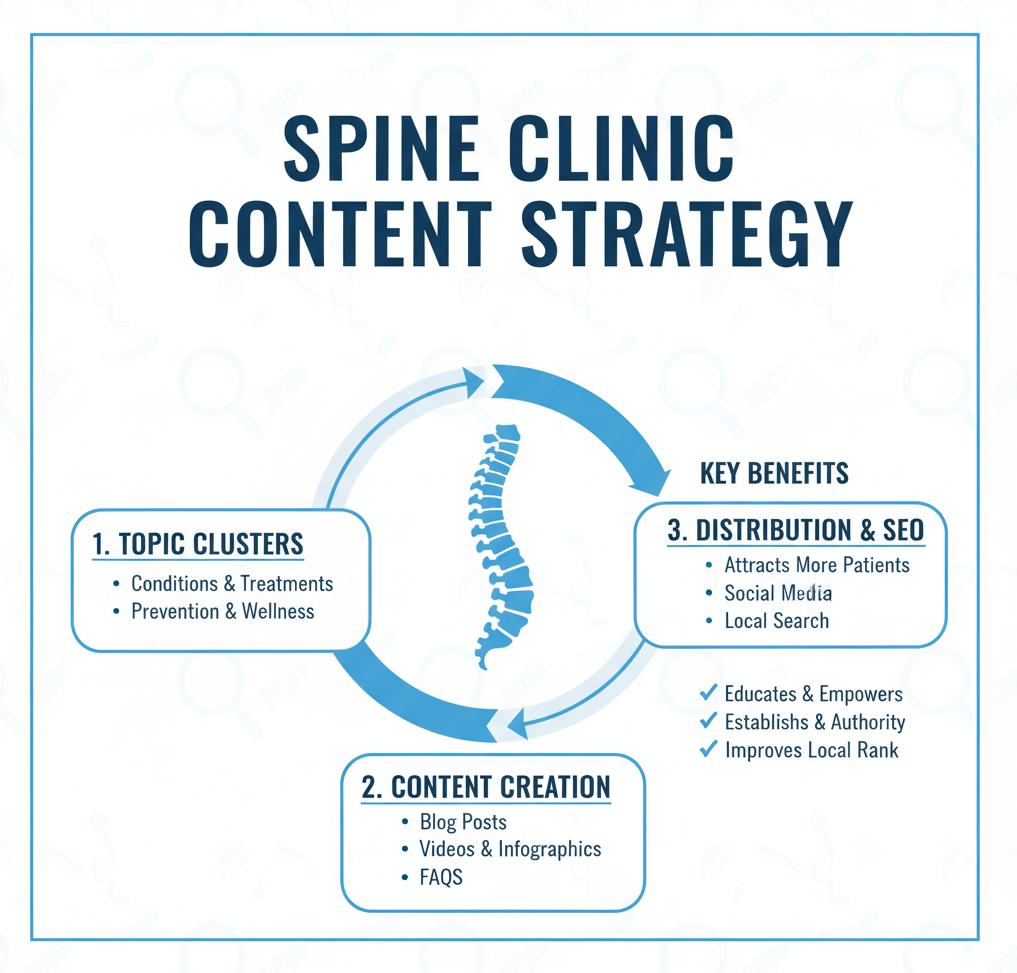
InvigoMedia: Your Partner in Building Healthcare Authority
Reading this, you might be thinking, “This sounds amazing, but I’m a doctor, not a full-time content creator and SEO specialist.” You’re right. Your time is best spent providing excellent care to your patients. Executing a high-level healthcare content marketing strategy requires expertise, resources, and consistent effort.
This is where InvigoMedia comes in. We are a specialized healthcare marketing agency that lives and breathes this work. We partner with spine clinics, chiropractors, and pain management specialists to build the exact kind of authority-driving Resource Hubs described in this guide.
Here’s how we transform your online presence:
- Custom Spine Clinic Content Strategy Development: We don’t use a one-size-fits-all approach. We begin by gaining a deep understanding of your practice, your ideal patients, your unique strengths, and your local market. We then build a comprehensive content plan tailored to your specific goals.
- Expert Content Creation: Our team comprises skilled writers, editors, and video producers specializing in the medical field. We create medically accurate, patient-friendly, and SEO-optimized content that resonates with your audience. From in-depth blog posts and treatment guides to professional exercise videos and patient testimonials, we handle the entire creation process.
- Advanced Medical SEO and Promotion: We ensure that the exceptional content we create is easily found. Our Medical SEO experts perform meticulous keyword research, optimize every piece of content, and build your website’s authority to rank for the high-intent keywords that drive patient appointments. We manage the promotion so your content reaches the right people at the right time.
- Measurable Results: Our goal is simple: to help you attract chiropractic patients and grow your practice. We track key metrics like organic traffic, keyword rankings, online appointment requests, and new patient calls. We provide transparent reporting, allowing you to see the direct impact of your investment.
Don’t let your expertise remain hidden behind a basic website. Partner with InvigoMedia to build a powerful online Resource Hub that establishes your clinic as the undeniable leader in spinal health in your community. Let us handle the marketing, so you can focus on what you do best—helping people live pain-free lives.
Contact InvigoMedia today for a free consultation, and let’s start building your authority.
Frequently Asked Questions (FAQs)
Q1: How often should our clinic be publishing new content?
A1: Consistency is more important than frequency. For most clinics, publishing one new, high-quality blog post or video per week is an excellent and sustainable goal. This keeps your website fresh, provides a steady stream of content for social media, and consistently signals to Google that your site is an active authority.
Q2: Should we focus solely on the specific services we offer?
A2: No, and this is a critical point. Your content strategy should be approximately 80% focused on addressing your patients’ problems, questions, and concerns (Awareness and Consideration stages), and only about 20% focused directly on your services and clinic (Decision stage). By generously providing helpful information, you build trust that naturally leads patients to your services when they’re ready.
Q3: Video production seems expensive and complicated. Is it really worth the investment?
A3: Absolutely. While professional video has a cost, its return on investment in terms of building trust and patient connection is unmatched. You can start simply with a good smartphone and a microphone for doctor Q&A videos. For higher-quality exercise demonstrations or patient testimonials, investing in a professional team pays dividends. Video is a key component of video marketing for physical therapy and chiropractic care, as it allows you to show, not just tell.
Q4: What is the main difference between content marketing and traditional SEO?
A4: Think of it this way: SEO is the technical foundation and the set of rules for getting found online. Content marketing is the high-quality fuel that powers the SEO engine. You can have a technically perfect website (good SEO), but without valuable content, Google has little reason to rank you. A great spine clinic content strategy is the most potent form of modern SEO.
Q5: How can we measure the success of our content marketing efforts?
A5: Success can be measured in several ways. You can track website traffic from organic search, monitor your rankings for target keywords (e.g., “sciatica treatment [Your City]”), count the number of leads from downloadable guides, and, most importantly, track the number of new patient inquiries that mention they found you through your blog or a helpful video. This is how you connect content directly to practice growth.
Q6: Do we need to be professional writers to create compelling blog content?
A6: You need to be an expert in your field, but not necessarily a professional writer. Your clinical knowledge is the most critical asset. However, the content must be well-structured, easy to read, and optimized for search engines. Many clinics achieve success by having their doctors outline the key medical points and then collaborating with a professional writer or an agency like InvigoMedia to transform that expertise into polished, compelling content.

